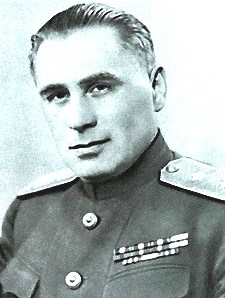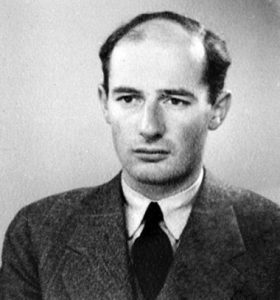07.07.2019
Raoul Wallenberg Research Initiative RWI-70
Press Release
EXCLUSIVE: Former Soviet State Security Official Lt. General Pavel Sudoplatov lied about the alleged poisoning death of Swedish diplomat Raoul Wallenberg
– In 1994, Pavel Sudoplatov admitted to Swedish officials that he based the claims contained in his memoir Special Tasks about Raoul Wallenberg’s alleged death by poisoning in 1947 entirely on information he had obtained from Russian media reports.
– Contrary to Sudoplatov’s claims, he was not simply an outside observer of the activities of the Soviey biochemist Grigory Mairanovsky, head of the infamous MGB Toxicological Laboratory. During the years 1942-1946, Mairanovsky’s laboratory was within Sudoplatov’s Terrorist Directorate, and from 1946 to 1950, Mairanovsky poisoned victims on direct orders of Sudoplatov. Consequently, if Stalin had ordered Mairanovsky to kill Raoul Wallenberg, Sudoplatov would have known about it and he did not have to guess.
– In 1946-1950, Sudoplatov knew the full background of his and Mairanovsky’s victims, including their names. However, until 1989, Sudoplatov did not know anything about Raoul Wallenberg and did not know his name. Therefore, Raoul Wallenberg was not part of these special killings ordered by Stalin and carried out by Sudoplatov and Mairanovsky in 1947.
– These facts were known to the joint Swedish-Russian Working Group that investigated the Wallenberg case during the 1990s but were not revealed in the group’s two official reports released in 2000.
– Sudoplatov’s statements in his 1994 memoir appear to have been part of deliberate Russian disinformation attempts, with the aim of closing the official Wallenberg investigation at the time.
– The current leadership of the Russian State Security Service (FSB) and, most likely, the Russian General Prosecutor’s Office that issued Raoul Wallenberg’s rehabilitation in 2000, apparently know the full truth about his fate.
– The findings raise important questions about the motivation of Russian officials to obstruct the Wallenberg inquiry for so long. They further underscore the need for researchers, Raoul Wallenberg’s family and especially the Swedish government to press Russian authorities for access to key documentation that currently remains classified in Russian archives.
For more information please contact:
Susanne Berger
Coordinator
THE RWI-70
www.rwi-70.de
6045 25th Rd N
Arlington, VA 22207 USA
Email: susanne.berger@rwi-70.de
Phone: + 1 571 594 1701
Svenska Dagbladet
Former Soviet State Security Chief Lt. General Pavel Sudoplatov lied about the alleged death by poison of Swedish diplomat Raoul Wallenberg
Säkerhetsrådet, July 7, 2019
Documentation obtained from Swedish government archives shows that the former Soviet State Security Lt. General Pavel Sudoplatov based his claims about Swedish diplomat Raoul Wallenberg’s alleged death by poisoning in 1947 entirely on information he had obtained from Russian media reports in 1993. Sudoplatov also seriously misrepresented his association with Grigory Mairanovsky’s Toxicological Laboratory from 1938 to 1946 and with Mairanovsky personally until 1950. The joint Swedish-Russian Working Group that investigated Raoul Wallenberg’s fate during the 1990s knew of these facts but did not reveal them in two official reports released in 2000. Sudoplatov’s claims appear to have been part of deliberate Russian disinformation attempts to close the Wallenberg case.
 In his memoir Specia Tasks, published in 1994, Soviet State Security Lt. General Pavel Sudoplatov stated that Swedish diplomat Raoul Wallenberg who disappeared in imprisonment in the Soviet Union in 1945,was most likely poisoned by the Soviet biochemist Grigory Mairanovsky in his infamous MGB toxicological laboratory in 1947. In 1944, the Swedish government appointed Wallenberg Secretary at its Legation in Budapest to help protect the lives of thousands of Hungarian Jews from Nazi persecution. In January 1945, Wallenberg was detained by the Soviet military counterintelligence SMERSH in Budapest and taken to Moscow. Successive Soviet and Russian governments claimed that he died or was executed in the summer of 1947, but the full circumstances of his fate have never been revealed.
In his memoir Specia Tasks, published in 1994, Soviet State Security Lt. General Pavel Sudoplatov stated that Swedish diplomat Raoul Wallenberg who disappeared in imprisonment in the Soviet Union in 1945,was most likely poisoned by the Soviet biochemist Grigory Mairanovsky in his infamous MGB toxicological laboratory in 1947. In 1944, the Swedish government appointed Wallenberg Secretary at its Legation in Budapest to help protect the lives of thousands of Hungarian Jews from Nazi persecution. In January 1945, Wallenberg was detained by the Soviet military counterintelligence SMERSH in Budapest and taken to Moscow. Successive Soviet and Russian governments claimed that he died or was executed in the summer of 1947, but the full circumstances of his fate have never been revealed.
It was assumed that as head of the State Security Ministry (MGB) terror and sabotage service, Sudoplatov had special inside knowledge about the Kremlin’s darkest secrets. In 1995, the American author andjournalist Kati Marton summed up the prevailing view: “While questions have been raised about some parts of Sudoplatov’s book, there is no reason to doubt him on the subject of Wallenberg.” However, documentation obtained from Swedish archives, as well as additional information collected from several Russian sources, strongly suggest that Sudoplatov’s statements appear to have been part of deliberate Russian disinformation attempts, with the aim of closing the official Wallenberg investigation during the 1990s.
Sudoplatov’sclaims aboutRaoul Wallenberg bear a striking similarity to the more recent publication of a chapter on the Wallenberg case included in the memoir of Ivan Serov, the former Chairman of the KGB, which was released in 2016. Anatoli Sudoplatov, Pavel Sudoplatov’s son and a Russian State Security Lt. Colonelin the reserve, played a central role in the inclusion of the questionable information about Raoul Wallenberg in both memoirs. This further heightens the suspicion that the two publications were part of apossible intentional effort byRussian authorities to put an end to the Wallenberg inquiry.Sudoplatov’s book was published while the official inquiry by the Swedish-Russian Working Group (1991-2000) was ongoing in Russia, whereas Serov’s memoir was released just before the start of a lawsuit filed by Wallenberg’s niece Marie von Dardel-Dupuy against the State Security Service (FSB) Central Archive in 2017.
When Swedish and Russian officials questioned Pavel Sudoplatov in June 1994, he freely admitted that he had obtained all information about the Raoul Wallenberg case entirely from Russian media sources. In a written response Sudoplatov explained:
“In (…) Special Tasks: Notes of an Unwanted Witness, which I co-authored, all considerations about Wallenberg’s fate are based on the interpretation of materials and documents published in our [Russian] press.”
Then he added:
“The version that Wallenberg was killed in [Grigory] Mairanovsky’s laboratory is presented in the book only as a hypothesis.”
Sudoplatov’s statement is found in the collection of papers of the Swedish-Russian Working Group, but has never been released to the public.
Even more importantly, in his memoir, Sudoplatov seriously misrepresented his personal and professional association with Mairanovsky. Contrary to Sudoplatov’s claims, he was not simply an outside observer of Mairanovsky’s activities but directly supervised his work. According to Russian documents, Sudoplatov knew the names and background of Mairanovsky’s victims killed in 1946-1950. Consequently, if Stalin and the Soviet leadership ordered Mairanovsky to poison Wallenberg, Sudoplatov would have known about that order and he would not have to guess. In fact, since mid-1946 Mairanovsky did no longer head the Toxicology Laboratory. Therefore, he could not have killed Wallenberg there. Itappears that Sudoplatov did not even know Wallenberg’s name until he was questioned about the case by the Russian journalist Vladimir Abarinov in 1989. “‘And who is this man [Wallenberg],’ – Sudoplatov asked Abarinov when the latter phoned him [about the Wallenberg case] – ‘I hear this name for the first time in my life’.”
Additionally, Yevgeny Pitovranov, former head of the MGB internal counterintelligence from 1946 to 1951, personally interviewed Sudoplatov after his memoir was published. Although the transcript remains classified, the Russian Working Group Report states: “No information on R. Wallenberg was found in [Sudoplatov’s] file and during [Pitovranov’s] interview.” All this means that by the end of 1994, both Swedish and Russian officials were fully aware thatSudoplatov knew nothing about Wallenberg. They also chose not toaddress Sudoplatov’s obvious misrepresentation about his direct interactions with Mairanovsky. In that sense, both reports are misleading. In fact, the Swedish report did not even mention that Swedish officials had interviewed Sudoplatov separately in 1994 and the clarifications he had provided.
 The Wallenberg case is not the only inaccurate claim about alleged poisonings in Sudoplatov’s memoir. He states that the famous Jewish actor Solomon Mikhoels and a secret MGB agent Vladimir Golubov-Potapov were “jabbed with a poison needle” in January 1948. But from the recently published documentation it is known that these two victims were assassinated on Stalin’s order without using poison.
The Wallenberg case is not the only inaccurate claim about alleged poisonings in Sudoplatov’s memoir. He states that the famous Jewish actor Solomon Mikhoels and a secret MGB agent Vladimir Golubov-Potapov were “jabbed with a poison needle” in January 1948. But from the recently published documentation it is known that these two victims were assassinated on Stalin’s order without using poison.
It’s possible that Sudoplatov’s “hypothesis” regarding Wallenberg’s alleged poisoning by Mairanovsky was primarily intended to indirectly confirm the official Soviet government’s version of Wallenberg’s death in his prison cell on July 17, 1947, supposedly of a heart attack.Apparently, the wish to stick to the official Soviet version of Wallenberg’s death also guided the decision by Soviet and later Russian officials to withhold for decades information about an unidentified Prisoner no. 7 who was interrogated on July 23, 1947, together with Wallenberg’s driver, the Hungarian citizen Vilmos Langfelder, for more than 16 hours. Only in 2009 did FSB archivists inform us that Prisoner no. 7 was “with great likelihood […] Raoul Wallenberg.” If true, this would mean Wallenberg was alive at least six days after his official date of death of July 17, 1947.
Together with these and other pertinent facts, Sudoplatov’s lies raise a crucial question about the possible motivations of Russian authorities behind the highly selective release of information in the Wallenberg case: Why does it remain so important for Russian authorities to adhere to the official version of Raoul Wallenberg’s death in Soviet imprisonment, even today? This attitude seems even more perplexing given the fact that there currently exists no confirmed evidence of Wallenberg’s long-term survival in the Soviet prison system.
The official Soviet version of Wallenberg’s death of a heart attack during investigation looks very suspicious. Usually this was the diagnosis given by prison doctors in cases when prisoners under investigation died as a result of torture and/or exhaustion. Also, in the late 1950s, heart attack (infarct) was frequently written in death certificates of those political prisoners who in Stalin’s time had been sentenced to death and shot. Therefore, all this points to the possibility that the attempts to cover up circumstances of Wallenberg’s death are aimed to conceal how and when he died.
The current FSB leadership and, most likely, the Russian General Prosecutor’s Office that issued Raoul Wallenberg’s rehabilitation in 2000, clearly know the full truth. Several high-ranking officials of Stalin’s Security Services lived well into the early 2000s. The former First KGB Deputy Chairman, Army General Filipp Bobkov died just last month, at age 93. Apparently, Bobkov was in charge when in 1989-1991 the KGB returned some of Wallenberg’s personal possessions, that had been “accidentally discovered” in the KGB Central Archive, to Nina Lagergren and Professor Guy von Dardel, Wallenberg’s half-sister and half-brother.
Researchers, Raoul Wallenberg’s family and especially the Swedish government must now urgently pressurethe FSB and the Russian government for the release of key information about Wallenberg’s fate that is still classifiedand that has been covered up for far too long.
Dr. Vadim Birstein, a biologist and historian, was a member of the first International Commission on Raoul Wallenberg headed by Prof. Guy von Dardel, Wallenberg’s half-brother, in 1990-91. He has published numerous articles on the Wallenberg caseandistheauthorofthebooks The Perversion of Knowledge: The True History of Soviet Science (2001) and the award winning SMERSH, Stalin’s Secret Weapon: Soviet Military Counterintelligence in WWII (2012) that was translated into several languages.
Susanne Berger is a historical researcher. From 1995-2000 she served as an independent consultant to the Swedish-Russian Working Group that investigated the fate of Swedish diplomat Raoul Wallenberg in Russia. She is the founder and coordinator of the Raoul Wallenberg Research Initiative (RWI-70).
Contact: info@fritz-bauer-blog.de
Foto: Pavel Sudoplatow ©By Mil.ru, CC BY 4.0, https://commons.wikimedia.org/w/index.php?curid=65984845; Raoul Wallenberg ©Raoul Wallenberg Research Initiative RWI-70.






